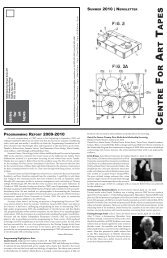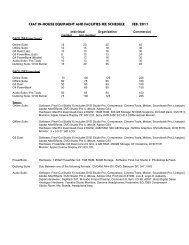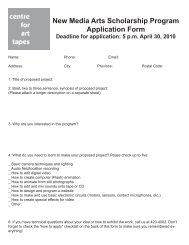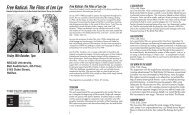video is a perceptual prosthetic - Centre for Art Tapes
video is a perceptual prosthetic - Centre for Art Tapes
video is a perceptual prosthetic - Centre for Art Tapes
Create successful ePaper yourself
Turn your PDF publications into a flip-book with our unique Google optimized e-Paper software.
the early 1980s) were ultimately successful inturning the media environment upside down.<strong>Art</strong><strong>is</strong>ts and independent media producershad a v<strong>is</strong>ion of a world where the productionand d<strong>is</strong>tribution of <strong>video</strong> data would be in thehands of everyone. Early in the 21st century<strong>video</strong> transm<strong>is</strong>sion <strong>is</strong> not confined to the topdown,one-to-many communications modelof telev<strong>is</strong>ion. We now live in a one-to-one,many-to-many transceiver culture.Marshall McLuhan, the literary h<strong>is</strong>torianand media environmental<strong>is</strong>t extraordinaire,once said that the greatest invention of the20th century was the instant replay. McLuhanwas fully aware of the groundbreaking workof Norbert Wiener, resulting in the birth ofthe field of cybernetics, the science of controlthrough feedback. McLuhan understood theunparalleled cultural acceleration that wouldoccur through feedback at electronic speedvery early. <strong>Art</strong><strong>is</strong>ts and independent media producerssimultaneously understood the powerof <strong>video</strong> through their hands-on work with<strong>video</strong> systems. Video magnified the powerof learning <strong>for</strong> all those who used it. Videomemory permitted the quick objectification ofexperience and establ<strong>is</strong>hed aroused expectationsas automated pre-perception (again,<strong>video</strong> can be seen to ‘perceive’ and transcribefaster than bioelectric human perception)and with its transm<strong>is</strong>sion and transcription ofreality to low-cost memory, a new era in theexchange of data, the sharing of experience,was initiated. We literally chase <strong>video</strong> recordingscognitively while they are being made.Video thus speeds up cognition, the recognitionof pattern, and ass<strong>is</strong>ts us in d<strong>is</strong>tingu<strong>is</strong>hingin<strong>for</strong>mation, those differences that make a difference,from massive fields of data. The <strong>video</strong>instrument lures us to experience the worldwith electronic speed and machine-enhancedfocus.Other prior media technologies had suchcataclysmic impacts. Photography, phonography(music recording), film, radio andtelephony, were, and continue to be, huge,trans<strong>for</strong>mative technologies. Photography,born in the mid-19th century, became andremained the people’s personal archival mediumthroughout in the 20th century. Film andcinematic storytelling were the predominantcultural <strong>for</strong>m of the 20th century. Telev<strong>is</strong>ionswept through technologically advancedsocieties reaching levels of saturation at anunprecedented speed in the late 1940s, earlyto mid-1950s. But <strong>video</strong> was the first accessibleelectronic audio/v<strong>is</strong>ual technology.Video was the beginning of the devolution oftelev<strong>is</strong>ion. Telev<strong>is</strong>ion had provided access tohuge audiences <strong>for</strong> corporate broadcasters ina rigid one-to-many, top-down communicationsstructure. Video was a decentralized,off-air, audio/v<strong>is</strong>ual technology. It allows the‘reading and writing’ of <strong>video</strong> data and in itsubiquitous presence and utility, facilitates amassive d<strong>is</strong>persal of <strong>video</strong> data, encouragingthe development of multiple points of viewand the ‘banking’ (in memory) and exchangeof same.Video exceeds the influence of photography,phonography, telephony, radio and filmbecause of its real time audio/v<strong>is</strong>ual sensorybase. Video ‘sees’ and ‘hears’ the way we doas a species, engaging the senses of sight andhearing, describing actions and environmentsin v<strong>is</strong>ual and acoustic space simultaneously,in real time, in the exact same time it takesthings to happen outside the domain of <strong>video</strong>.Video engages the two primary ‘windows’ ofour sensorium and also resonates with oursenses of time and balance. While it <strong>is</strong> truethat <strong>video</strong> <strong>is</strong> no less synthetic a reality thanphotography, phonography, film, telephony,radio or telev<strong>is</strong>ion, we perceive the immediatesonic and v<strong>is</strong>ual d<strong>is</strong>play of <strong>video</strong> as an augmented,enhanced reality, not as a mediated,7






